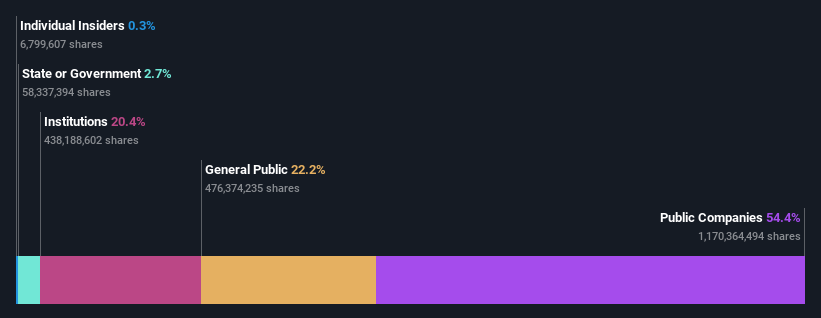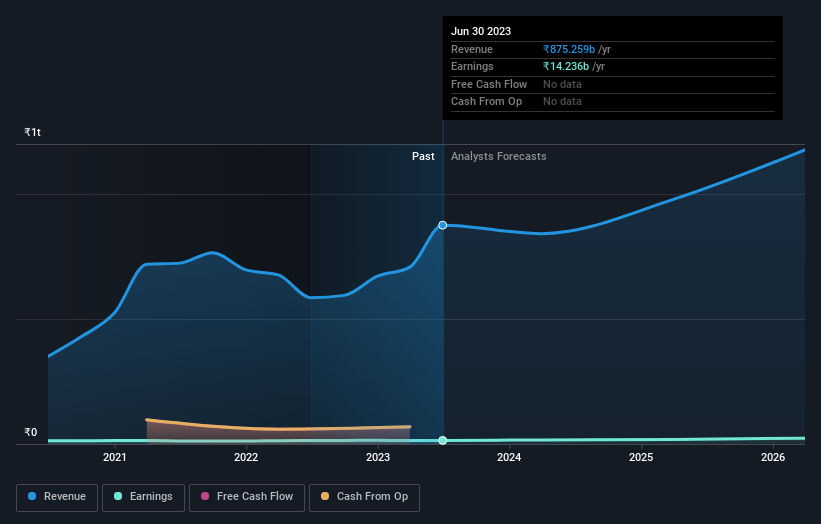Individual investors own 22% of HDFC Life Insurance Company Limited (NSE:HDFCLIFE) shares but public companies control 54% of the company

Key Insights
- HDFC Life Insurance's significant public companies ownership suggests that the key decisions are influenced by shareholders from the larger public
- The largest shareholder of the company is HDFC Bank Limited with a 50% stake
- Recent sales by insiders
Every investor in HDFC Life Insurance Company Limited (NSE:HDFCLIFE) should be aware of the most powerful shareholder groups. We can see that public companies own the lion's share in the company with 54% ownership. Put another way, the group faces the maximum upside potential (or downside risk).
Meanwhile, individual investors make up 22% of the company’s shareholders.
Let's take a closer look to see what the different types of shareholders can tell us about HDFC Life Insurance.
See our latest analysis for HDFC Life Insurance

What Does The Institutional Ownership Tell Us About HDFC Life Insurance?
Many institutions measure their performance against an index that approximates the local market. So they usually pay more attention to companies that are included in major indices.
As you can see, institutional investors have a fair amount of stake in HDFC Life Insurance. This implies the analysts working for those institutions have looked at the stock and they like it. But just like anyone else, they could be wrong. It is not uncommon to see a big share price drop if two large institutional investors try to sell out of a stock at the same time. So it is worth checking the past earnings trajectory of HDFC Life Insurance, (below). Of course, keep in mind that there are other factors to consider, too.

HDFC Life Insurance is not owned by hedge funds. HDFC Bank Limited is currently the company's largest shareholder with 50% of shares outstanding. This essentially means that they have extensive influence, if not outright control, over the future of the corporation. With 4.0% and 2.7% of the shares outstanding respectively, Exide Industries Limited and Singapore are the second and third largest shareholders.
While studying institutional ownership for a company can add value to your research, it is also a good practice to research analyst recommendations to get a deeper understand of a stock's expected performance. Quite a few analysts cover the stock, so you could look into forecast growth quite easily.
Insider Ownership Of HDFC Life Insurance
The definition of company insiders can be subjective and does vary between jurisdictions. Our data reflects individual insiders, capturing board members at the very least. The company management answer to the board and the latter should represent the interests of shareholders. Notably, sometimes top-level managers are on the board themselves.
Most consider insider ownership a positive because it can indicate the board is well aligned with other shareholders. However, on some occasions too much power is concentrated within this group.
Our data suggests that insiders own under 1% of HDFC Life Insurance Company Limited in their own names. As it is a large company, we'd only expect insiders to own a small percentage of it. But it's worth noting that they own ₹4.2b worth of shares. In this sort of situation, it can be more interesting to see if those insiders have been buying or selling.
General Public Ownership
The general public-- including retail investors -- own 22% stake in the company, and hence can't easily be ignored. While this group can't necessarily call the shots, it can certainly have a real influence on how the company is run.
Public Company Ownership
Public companies currently own 54% of HDFC Life Insurance stock. It's hard to say for sure but this suggests they have entwined business interests. This might be a strategic stake, so it's worth watching this space for changes in ownership.
Next Steps:
While it is well worth considering the different groups that own a company, there are other factors that are even more important. Take risks for example - HDFC Life Insurance has 2 warning signs we think you should be aware of.
Ultimately the future is most important. You can access this free report on analyst forecasts for the company.
NB: Figures in this article are calculated using data from the last twelve months, which refer to the 12-month period ending on the last date of the month the financial statement is dated. This may not be consistent with full year annual report figures.
Valuation is complex, but we're here to simplify it.
Discover if HDFC Life Insurance might be undervalued or overvalued with our detailed analysis, featuring fair value estimates, potential risks, dividends, insider trades, and its financial condition.
Access Free AnalysisHave feedback on this article? Concerned about the content? Get in touch with us directly. Alternatively, email editorial-team (at) simplywallst.com.
This article by Simply Wall St is general in nature. We provide commentary based on historical data and analyst forecasts only using an unbiased methodology and our articles are not intended to be financial advice. It does not constitute a recommendation to buy or sell any stock, and does not take account of your objectives, or your financial situation. We aim to bring you long-term focused analysis driven by fundamental data. Note that our analysis may not factor in the latest price-sensitive company announcements or qualitative material. Simply Wall St has no position in any stocks mentioned.
About NSEI:HDFCLIFE
HDFC Life Insurance
Provides individual and group insurance solutions in India.
Solid track record with adequate balance sheet.
Similar Companies
Market Insights
Community Narratives



